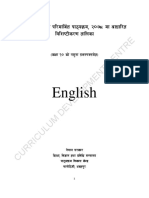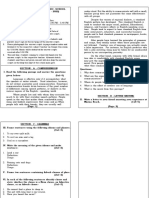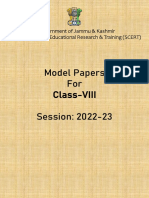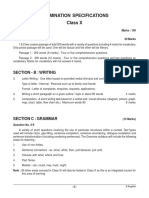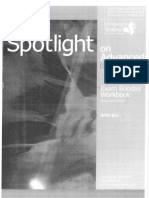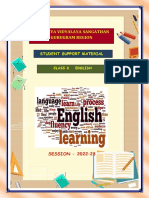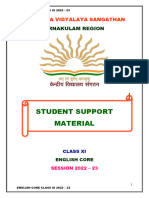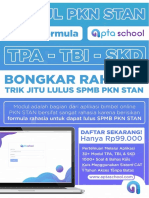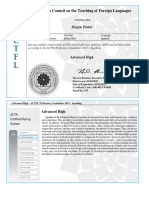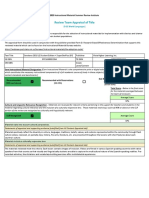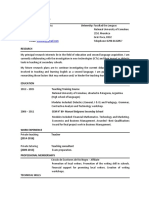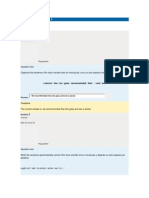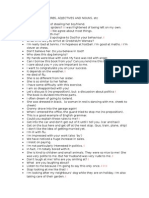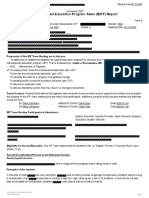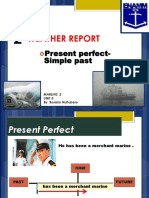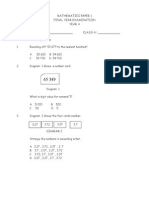Presidential Schools Grade 5
Selection Test
English Test Specification
Transforming societies
through education
�English Test Specification 1
Table of Contents
1. Presidential Schools of Uzbekistan ..................................................................... 2
2. Structure of the admissions test process ............................................................ 2
3. Purpose of the selection test ............................................................................... 3
4. The English test .................................................................................................. 3
5. Structure of the English test ................................................................................ 4
6. Sample questions................................................................................................ 5
Understanding the purpose of a short text giving instructions ................................ 5
Questions 1-5 ......................................................................................................... 5
Understanding the meaning of a word, phrase or sentence ................................... 5
Questions 6-10 ....................................................................................................... 5
Understanding the functional purpose of an exchange ........................................... 6
Questions 11-15...................................................................................................... 6
Identifying the appropriate vocabulary or grammatical option................................. 6
Questions 16-20 ..................................................................................................... 6
Identifying the appropriate vocabulary or grammatical option................................. 7
Questions 21-25 ..................................................................................................... 7
Understanding a detail ............................................................................................ 8
Questions 26-30 ..................................................................................................... 8
Understanding a detail ............................................................................................ 9
Questions 31-35 ..................................................................................................... 9
Understanding a detail .......................................................................................... 10
Questions 36-40 ................................................................................................... 10
7. Rules for selecting candidates for admission .................................................... 11
Transforming societies
through education
�English Test Specification 2
1. Presidential Schools of Uzbekistan
The Agency for Presidential Educational Institutions of the Republic of Uzbekistan
(PIIMA) has established 14 Presidential Schools across Uzbekistan to provide young
people with a world-class secondary education.
These Presidential Schools aim to “prepare the next generation of leaders to actively
and positively contribute to the development of Uzbekistan”.
The PIIMA Presidential Schools programme aims to “support and encourage gifted
youth” and produce an “intellectually-developed generation.”
The main priorities of Presidential Schools include:
Selecting and educating gifted children, creating conditions for their full
development
Promoting in-depth study of sciences, foreign languages, engineering and
information technologies
Establishing modern methods of teaching and assessing students’ knowledge
Developing students’ leadership, public speaking, critical thinking and analysis
skills
Ensuring student participation in international Olympiads and competitions
Establishing cooperation with national and international education institutions
To support the aims of the Presidential Schools, a competitive admissions test has
been designed by Cambridge University Press and Assessment.
2. Structure of the admissions test process
The admissions test comprises two stages. The pre-selection test of Mathematics
and the main selection test of English Language, Problem Solving and Critical
Thinking. Together, Problem Solving and Critical Thinking are referred to as
“Thinking Skills”.
Candidates in each region who achieve the highest scores in the pre-selection test
will progress to the main selection test. The tests of Mathematics and Thinking Skills
are available in three languages: Uzbek, Karakalpak and English.
Transforming societies
through education
�English Test Specification 3
3. Purpose of the selection test
The purpose of the selection test is to allocate places in the Presidential Schools
fairly, objectively and impartially to the most able candidates from each region. These
candidates will be those who are most able to fulfil the aims of the Presidential
Schools of Uzbekistan.
4. The English test
English is the language of teaching in the Presidential Schools of Uzbekistan, and
English is therefore essential for accessing all parts of the curricula, and a
foundational skill for success in the schools.
The English test is aligned with the CEFR levels of A1 to A2, with some items
targeting pre-A1 and B1. These are levels on the Common European Framework of
Reference for Languages (CEFR), an international standard for describing language
ability on a six-point scale, from pre-A1 for beginners, up to C2 for those who have
mastered a language.
Common European Framework of Reference for Languages (CEFR)
Beginner Basic Independent Proficient
Pre-A1 A1 A2 B1 B2 C1 C2
Transforming societies
through education
�English Test Specification 4
5. Structure of the English test
The English test consists of one 40-minute paper. The paper contains 40 multiple-
choice questions, with three options to choose from per question. Each question is
worth one mark.
The test is divided into eight sections, as follows:
Questions Task type Testing focus Function
1-5 Notices and messages Careful reading Understand the purpose of a
short text giving instructions
6-10 Definitions Lexical Understand the meaning of a
word, phrase or sentence
11-15 Social dialogues Lexico- Understand the functional
grammatical purpose of an exchange
16-20 Sentences with multiple- Lexico- Identify the appropriate
choice gap-fill questions grammatical vocabulary or grammatical option
21-25 Text with multiple-choice Lexico- Identify the appropriate
gap-fill questions grammatical vocabulary or grammatical option
26-30 Text with multiple-choice Careful reading Understand a detail
questions
31-35 Matching a detail to a text Expeditious Understand a detail
reading
36-40 Text with multiple-choice Careful reading Understand a detail
questions
Candidates record their answers on a separate answer sheet. After the test the
answer sheet is scanned to enter the marks onto an electronic system.
There is no penalty for incorrect answers, so candidates are advised to answer all
the questions in the paper.
Examples of each of the question types are given in Section 6.
Transforming societies
through education
�English Test Specification 5
6. Sample questions
The English test does not assess knowledge of a curriculum. To help test-takers and
other stakeholders understand the style of questions that will be in the test, we have
included below an example of each question type in this document.
For the text-based questions, only the section of text relevant to the sample question
is included.
Understanding the purpose of a short text giving instructions
Questions 1-5
Candidates read five real-world texts and select the main message.
Example
For these questions, choose the correct answer A, B or C.
Visitors to the Museum Garden must not
A eat in the garden.
B drop any rubbish.
C use the café tables for picnics.
Correct answer: B
Understanding the meaning of a word, phrase or sentence
Questions 6-10
Candidates read five definitions and select the word(s) defined.
Example
This is a big animal with four legs. You can ride it.
A a fish
B a bird
C a horse
Correct answer: C
Transforming societies
through education
�English Test Specification 6
Understanding the functional purpose of an exchange
Questions 11-15
Candidates read five brief dialogues between two people, and decide how the
second speaker should respond each time.
Example
Correct answer: C
Identifying the appropriate vocabulary or grammatical option
Questions 16-20
Candidates read five sentences with gaps and choose which word goes in each gap.
Example
Read the sentences about Zoe and her school.
For each space, choose the correct answer A, B or C.
Zoe goes to a school that’s …………… her home.
A near B from C between
Correct answer: A
Transforming societies
through education
�English Test Specification 7
Identifying the appropriate vocabulary or grammatical option
Questions 21-25
Candidates read a short factual text with some gaps and choose the correct words to
complete the gaps.
Example
Read the text about two buildings.
For each space, choose the correct answer A, B or C.
Two buildings with amazing roofs
The Sydney Opera House has one of the most famous roofs in the world. The
architect who designed it loved sailing, (22)…………... he made the roof look
like the sails of boats.
A because B so C or
Correct answer: B
Transforming societies
through education
�English Test Specification 8
Understanding a detail
Questions 26-30
Candidates read a longer text (approx. 250-270 words) for detailed understanding
and main ideas, and answer five multiple-choice questions.
Example
Read the text about a young woman who flew a plane around the world.
For each question, choose the correct answer A, B or C.
19-year-old Zara Rutherford recently became the youngest woman to fly around
the world alone. She had planned to do it in three months, but problems on the
way added two months to her journey. She finally got home five months after
leaving.
How long did Zara’s journey take?
A two months
B three months
C five months
Correct answer: C
Transforming societies
through education
�English Test Specification 9
Understanding a detail
Questions 31-35
Candidates read five questions on three short texts on the same topic, then match
each question to the correct text.
Example
Read the texts below and the questions that follow.
For each question, choose the correct answer A, B or C.
Shopping
Alessia
There’s a great shopping centre in my town. My friends and I go there
together most weekends. It’s got clothes shops, sports shops, jewellery
shops – every kind, really. We don’t buy much. We just look around and
hang out. Sometimes I look at shopping websites on my phone, when I’m
at home. I think about things I’d like to buy when I’m older and have a job.
Max
I didn’t enjoy going to shops when I was younger because I thought it was
boring. But a few months ago, I found a great sports shop in the city, and I
loved it. Then a similar one opened in my local town, and now I go there a
lot. Actually, I don’t go in any other type of shop. This one has everything I
need. Most of my friends go there, and it’s got a great website, too.
Clara
My older sister loves going out to the shops, but I don’t. If I have to go and
choose a present for someone I’ll go, but I never go just for fun. I think it’s
better to look for things to buy on the internet. It’s easier to find exactly
what you’re looking for. When you go into clothes shops, for example,
they often don’t have your size, or the right colour.
Who prefers online shopping to going out shopping?
A Alessia
B Max
C Clara
Correct answer: C
Transforming societies
through education
�English Test Specification 10
Understanding a detail
Questions 36-40
Candidates read a longer text (approx. 250-270 words) for detailed understanding
and main ideas, and answer five multiple-choice questions.
Example
Read the text about a girl who makes podcasts.
For each question, choose the correct answer A, B or C.
My life as a podcaster
by 14 year-old Maya Fellows
When I was 9, I started listening to podcasts for children – talk shows
that you download from the internet – but all I could find were kids’
stories, or shows about fashion. I wanted to understand the news, but
there was nothing available, so I decided to start one myself.
What is Maya’s podcast about?
A fashion
B news
C science
Correct answer: B
Transforming societies
through education
�English Test Specification 11
7. Rules for selecting candidates for admission
Scores in the Selection Test determine the 24 applicants in each region who will be
admitted to a Presidential School.
The Selection Test consists of two papers: the test of Thinking Skills and the test of
English. 40 questions assess candidates’ thinking skills and 40 questions assess
their English language skills. However, in view of the importance of well-developed
thinking skills as a predictor of academic success, candidates’ scores for the
Thinking Skills paper are doubled to give a maximum possible of 80 marks.
Although 40 questions are likewise needed to reliably measure candidates’ English
language skills, this part of the test is less crucial as a predictor of academic
success, so candidates’ scores for English are halved to give a maximum possible of
20 marks.
The maximum ‘weighted’ scores of 80 for Thinking Skills and 20 for English combine
to give a practical, easy to use maximum score of 100 for the Selection Test as a
whole.
This score out of 100 is used to rank candidates in descending order. The top 24
candidates in each region are awarded a place in the Presidential School in their
region. Where there are tied scores around 24th place in the rank order, preference
is given to the candidate with the highest score for Thinking Skills and, if still tied,
with the highest score on the following components in the following order of priority:
1. The score on the problem solving component in Thinking Skills.
2. (If still tied) the score on the critical thinking component in Thinking Skills.
3. (If still tied) the score on the reading component in English.
4. (If still tied) the score on the grammar component in English.
If candidates’ scores are still tied, the younger candidate will be ranked higher.
Transforming societies
through education
�Cambridge University Press & Assessment
The Triangle Building
Shaftesbury Road
Cambridge
CB2 8EA
United Kingdom
partnership@cambridge.org cambridge.org/partnership +44 1223 358331
© Cambridge University Press & Assessment 20245








